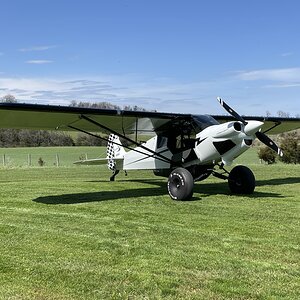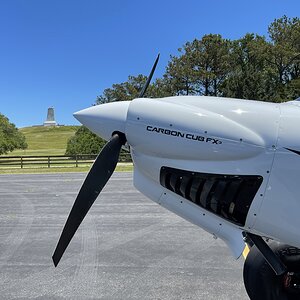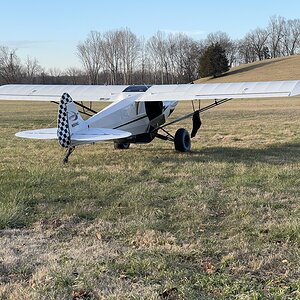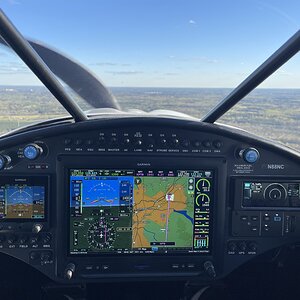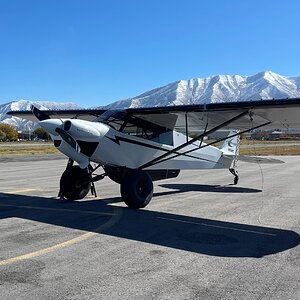Navigation
Install the app
How to install the app on iOS
Follow along with the video below to see how to install our site as a web app on your home screen.
Note: This feature may not be available in some browsers.
More options
Welcome to Flightinfo.com
- Register now and join the discussion
- Friendliest aviation Ccmmunity on the web
- Modern site for PC's, Phones, Tablets - no 3rd party apps required
- Ask questions, help others, promote aviation
- Share the passion for aviation
- Invite everyone to Flightinfo.com and let's have fun
You are using an out of date browser. It may not display this or other websites correctly.
You should upgrade or use an alternative browser.
You should upgrade or use an alternative browser.
Piper Arrow Vs. Cessna 172RG
- Thread starter Steve
- Start date
- Watchers 12
they are both good trainers. I would personally recommend the arrow for 2 reasons:
1) IF YOU ARE PLANNING ON MULTIENGINE TRAINING THE ARROW IS AN EXCELLENT TRANSITION INTO SOME OF THE MORE COMMONON TWINS(SENECA/SEMINOLE)-AS IT IS BASICALLY THE SAME MINUS THE OTHER ENGINE.
2) MOST OF YOUR PREVIOUS EXPERIENCE HAS BEEN IN CESSNA PRODUCTS AND EXPOSURE TO DIFFERENT EQUIPMENT AND A LOW WING AIRCRAFT IS VERY BENEFICIAL! I feel the systems set-up on the arrow, (like retractable gear,) are more more representative of of light twins than is the 172-rg.
1) IF YOU ARE PLANNING ON MULTIENGINE TRAINING THE ARROW IS AN EXCELLENT TRANSITION INTO SOME OF THE MORE COMMONON TWINS(SENECA/SEMINOLE)-AS IT IS BASICALLY THE SAME MINUS THE OTHER ENGINE.
2) MOST OF YOUR PREVIOUS EXPERIENCE HAS BEEN IN CESSNA PRODUCTS AND EXPOSURE TO DIFFERENT EQUIPMENT AND A LOW WING AIRCRAFT IS VERY BENEFICIAL! I feel the systems set-up on the arrow, (like retractable gear,) are more more representative of of light twins than is the 172-rg.
bobbysamd
Well-known member
- Joined
- Nov 26, 2001
- Posts
- 5,710
Cessna RGs v. Arrow
I don't have any 172RG time, but I do have time in Cardinal (177) RGs and a bunch of time in Skylane RGs.
Both would be fine, six of one and half a dozen of another. Bigsky makes a good point that Arrows are closer to the light twins that you may fly eventually. In fact, a Seminole is very much a twin-engined Arrow. So, if you fly Arrows and know you will be flying Seminoles, you'll have an easy transition. But, it probably doesn't really matter. At ERAU we had students who went through the single-engine Commercial program in 172s and the retractable Skylanes. They added their multis in the Seminoles and did just fine.
Hope that helps a little.
I don't have any 172RG time, but I do have time in Cardinal (177) RGs and a bunch of time in Skylane RGs.
Both would be fine, six of one and half a dozen of another. Bigsky makes a good point that Arrows are closer to the light twins that you may fly eventually. In fact, a Seminole is very much a twin-engined Arrow. So, if you fly Arrows and know you will be flying Seminoles, you'll have an easy transition. But, it probably doesn't really matter. At ERAU we had students who went through the single-engine Commercial program in 172s and the retractable Skylanes. They added their multis in the Seminoles and did just fine.
Hope that helps a little.
NoPlaneNoGain
Well-known member
- Joined
- Nov 26, 2001
- Posts
- 97
Glideslope!
Member
- Joined
- May 1, 2002
- Posts
- 21
Looking at your experience I see that you haven't flown a piper yet. I'll agree with Bigsky. He has a good point about transistioning to a twin. It is also good to fly different kinds of airplanes. The transition to the Piper might be more difficult but, you will learn more about how different airplanes fly.
As far as putting the gear up in a Cessna 172RG because you're too low, that is a mistake. Putting the gear up in the C172RG initially adds drag and drops the gear lower.
Good luck. The Piper will be a nice change of pace for you.
As far as putting the gear up in a Cessna 172RG because you're too low, that is a mistake. Putting the gear up in the C172RG initially adds drag and drops the gear lower.
Good luck. The Piper will be a nice change of pace for you.
atpcliff
Well-known member
- Joined
- Nov 26, 2001
- Posts
- 4,260
Hi!
Do NOT WASTE YOUR MONEY!!!!
After having been to 5 airline interviews, the ALL ask about Airplane Multi-Engine time!!!
If you're flying and airplane, that's good. If it's NOT MULTI, they don't care if it's a Meridian (single turbine, high performance), or it's a Piper Cub.
Save your money and fly a 152/172/Warrier/Mooney Cadet, etc. As far as the airlines go, they don't care. It's easy to get your high performance sign-off afterward, if you need it-one flight with a flight instructor and you're good to go.
The only SE time that will help is an F-16, or similiar SE fighter, and you can't afford the hourly cost for one of those!
Good luck with your aviation career. I'm proof that if you stick with it, good things can happen!
Cliff
GB,WI
Do NOT WASTE YOUR MONEY!!!!
After having been to 5 airline interviews, the ALL ask about Airplane Multi-Engine time!!!
If you're flying and airplane, that's good. If it's NOT MULTI, they don't care if it's a Meridian (single turbine, high performance), or it's a Piper Cub.
Save your money and fly a 152/172/Warrier/Mooney Cadet, etc. As far as the airlines go, they don't care. It's easy to get your high performance sign-off afterward, if you need it-one flight with a flight instructor and you're good to go.
The only SE time that will help is an F-16, or similiar SE fighter, and you can't afford the hourly cost for one of those!
Good luck with your aviation career. I'm proof that if you stick with it, good things can happen!
Cliff
GB,WI
captjim
Well-known member
- Joined
- Dec 2, 2001
- Posts
- 461
atpcliff said:Hi!
Do NOT WASTE YOUR MONEY!!!!
After having been to 5 airline interviews, the ALL ask about Airplane Multi-Engine time!!!
If you're flying and airplane, that's good. If it's NOT MULTI, they don't care if it's a Meridian (single turbine, high performance), or it's a Piper Cub.
Save your money and fly a 152/172/Warrier/Mooney Cadet, etc. As far as the airlines go, they don't care. It's easy to get your high performance sign-off afterward, if you need it-one flight with a flight instructor and you're good to go.
The only SE time that will help is an F-16, or similiar SE fighter, and you can't afford the hourly cost for one of those!
Good luck with your aviation career. I'm proof that if you stick with it, good things can happen!
Cliff
GB,WI
I agree, go with the cheapest. Both aircraft have there benifits, but the cheapest would prevail if I were you. I trained in cessnas almost exclusively and when the time came to fly something different there really wasent anything unexpected. To me pipers were easier to fly and land. As a flight instructor I perfered my students to train in cessnas as opposed pipers, they just seemed more demanding of attention. Point being go with the cheapest now and take the extra money for multi time.
It is my understanding that a high-performance sign-off (one-time endorsement) can be acheived by demonstrating profiecency in EITHER an a/c with more than 200 hp OR one with retractable landing gear, flaps and a controllable-pitch propeller (obviously most FBO'S would require a certain amount of retractable experience if you obtained this one-time endorsement in a high-performance fixed gear).
It's been a while since I've instructed (1987), so the rules may have changed, but thats the way it used to be.
It's been a while since I've instructed (1987), so the rules may have changed, but thats the way it used to be.
eaglefly-
It used to be that the complex and high performance endorsements were one in the same and there was no requirement for horsepower. I don't remember exactly when the horsepower requirement was introduced, but I think it was in the early 90's sometime. The complex and high performance were seperated and the "more than 200 horsepower" requirement for the high performance was added in. There were many flight schools that used the Piper Arrow or Mooney, which only had 200 HP, for the commercial rating which would give you the endorsement for the complex and high perf. After the HP requirement, you could only get the complex from these aircraft.
It used to be that the complex and high performance endorsements were one in the same and there was no requirement for horsepower. I don't remember exactly when the horsepower requirement was introduced, but I think it was in the early 90's sometime. The complex and high performance were seperated and the "more than 200 horsepower" requirement for the high performance was added in. There were many flight schools that used the Piper Arrow or Mooney, which only had 200 HP, for the commercial rating which would give you the endorsement for the complex and high perf. After the HP requirement, you could only get the complex from these aircraft.
Mitsipilot
Well-known member
- Joined
- Jan 15, 2002
- Posts
- 60
Arrow
I assume you want to use one of these airplanes for your commercial certificate?? You will need at least 10 hours of training in a complex airplane, and either one will work fine for this purpose. HOWEVER, if you do choose the Arrow, as I did, it will help to practice in the Warrior/Archer/Cherokee class for a few hours to get used to the handling characteristics and fuel management issues before having to worry about a faster, more complex airplane. Around here Warriors and C172's rent for the same price (Arrows are more expensive), so if you need to build some more time get a few hours in a Warrior and you'll have no problem getting used to the Arrow in 10 hours.
I assume you want to use one of these airplanes for your commercial certificate?? You will need at least 10 hours of training in a complex airplane, and either one will work fine for this purpose. HOWEVER, if you do choose the Arrow, as I did, it will help to practice in the Warrior/Archer/Cherokee class for a few hours to get used to the handling characteristics and fuel management issues before having to worry about a faster, more complex airplane. Around here Warriors and C172's rent for the same price (Arrows are more expensive), so if you need to build some more time get a few hours in a Warrior and you'll have no problem getting used to the Arrow in 10 hours.
I also say go with the cheapest. You can do alot of your training in a non complex a/c and just prepare for taking the checkride in the complex. The 172RGs are nice, relatively simple, and slow in the summer. I took my commercial in the arrow and I enjoyed flying them. The only trick was the automatic gear extend system which had to be overridden during certain commercial maneuvers and adds to the procedures. We also had one where the switch was loosy goosey and tended to slip so the gear would fall halfway up your chandelle or lazy eight. I believe there have been some insurance issues with this system since so they may all be deactivated now. Other than the training complexities it was an o.k. system in my opinion.
I would also agree that varied experience is a benefit. So if you want to, fly in something different like the arrow.
Good luck.
I would also agree that varied experience is a benefit. So if you want to, fly in something different like the arrow.
Good luck.
JetPilot500
Well-known member
- Joined
- Dec 5, 2001
- Posts
- 335
I've flown both...both are fun to fly. If I had to pick, I choose the Arrow. Why, I preferred the low wing and the real throttle as opposed to the push/pull knob...LOL!
But seriously, my real reason, I like the idea that the gear can freefall and lock in the event of a problem with your airplane. That complicated gear system in the Cessna RG's is too weird, and there have been too many problems with that system.
Other than that, it comes down to preference and/or costs.
Enjoy,
JetPilot500
But seriously, my real reason, I like the idea that the gear can freefall and lock in the event of a problem with your airplane. That complicated gear system in the Cessna RG's is too weird, and there have been too many problems with that system.
Other than that, it comes down to preference and/or costs.
Enjoy,
JetPilot500
Just a quick note...
Not all Arrows have the auto-drop gear system that has been refered to in this thread. I flew the Arrow III and it did not have this auto-drop feature. If I remember correctly the Arrow II and I think the Arrow IV had this auto-drop feature, which did have a switch to dissable it during training maneuvers.
Not all Arrows have the auto-drop gear system that has been refered to in this thread. I flew the Arrow III and it did not have this auto-drop feature. If I remember correctly the Arrow II and I think the Arrow IV had this auto-drop feature, which did have a switch to dissable it during training maneuvers.
Latest posts
-
-
-
Question Piston engine compression checks - 14mm vs 18mm testing?
- Latest: Cactus Charlie
-
Latest resources
-
-
-
-
-
AC 90-89C - Amateur-Built Aircraft and Ultralight Flight Testing HandbookAmateur-Built Aircraft and Ultralight Flight Testing Handbook
- Neal
- Updated:

